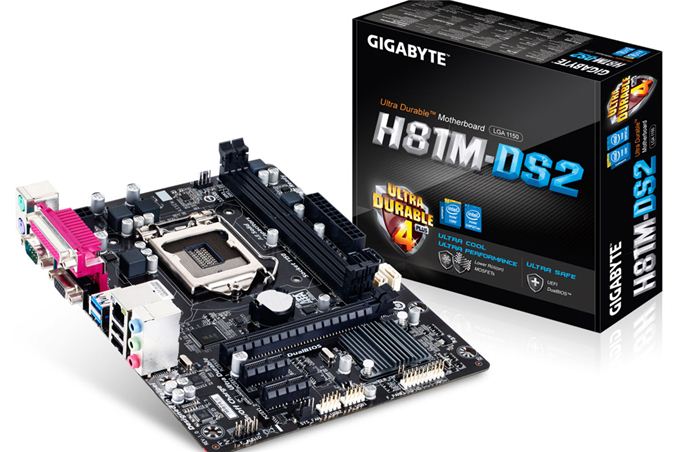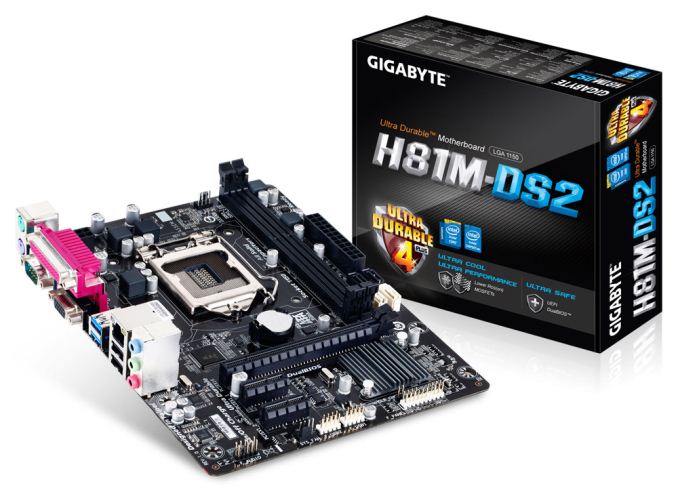GIGABYTE Launch H81 Series Motherboards
by Ian Cutress on August 24, 2013 7:31 AM EST- Posted in
- Motherboards
- Gigabyte
- Haswell
- H81

When it comes to our motherboard reviews, we typically attempt to focus on the high sellers with distinguishing features - this normally means chipsets aimed at the mainstream to high end with more capabilities. Every so often we touch on something aimed more at the entry level or a cheaper chipset, and today GIGABYTE are launching their H81 series motherboards - entry level for Haswell.
To put H81 into perspective, the chipset offers two SATA 6 Gbps ports, two USB 3.0 ports, no RAID, no Smart Response Technology, a single PCIe 2.0 x16 from the CPU and six PCIe 2.0 lanes from the chipset.
GIGABYTE's H81 range covers both thinner ATX and micro-ATX motherboards, where PCIe 2.0 x1 and PCI ports occupy the extra slots down the motherboard. The range will have seven SKUs, four of which are available online:
| GA-H81-D3 | GA-H81M-S2PV | GA-H81M-S2PH | GA-H81M-DS2 |
| GA-H81M-HD3 | H81M-H | H81.AMP-UP |
All the motherboards will feature Ultra Durable 4 PLUS, which means 40A IR3550 ICs in the power delivery (all boards seem to feature a 2+1 VRM arrangement), as well as the new HD BIOS and GIGABYTE App Center which we examined on Z87. GIGABYTE state that some models will also be equipped with a USB 3.0 hub to increase USB 3.0 ports up to six, although none of the four models currently online do so, thus it seems reserved for the H/HD versions. All the online models contain Realtek NICs and audio codecs, as well as either a serial or a parallel port or both:
No word on pricing or which regions these motherboards will be aimed for. The interesting part from this PR is the H81.AMP-UP model, which would suggest that some of the G1.Sniper Z87 or A88X features are coming to H81: either the OP-AMP (adjustable amplifier) or USB DAC-UP (cleaner USB power for DACs) or both. This could potentially be good news, as typically entry-level chipsets are paired with ALC887 codecs or similar.
I rarely (once or twice a year) get requests to review motherboards based on entry-level chipsets - there is not much to test and rarely anything new for comparison or explanation. However this PR gives an opportunity to ask our readers if you would be interested in such a review?
Update 08/25: Since the initial PR, GIGABYTE have upped the number of H81 motherboards to 10:
This list now includes access to the HD3, the D2V, and D3V, all of which feature the USB 3.0 hub as mentioned in the original PR.

















24 Comments
View All Comments
Fat80y - Saturday, August 24, 2013 - link
Very interested in a review. No features should mean low power consumption. Excellent for office pc, linux firewall, homebrew nas and the like.DarkStryke - Saturday, August 24, 2013 - link
Except they're running low end realtec NIC's, which no nas should be using.savagemike - Saturday, August 24, 2013 - link
Would totally be interested in a review. Always interesting to see just how much you are gaining in performance for the extra money of the high end boards. Also where critical corners may have been cut.The extra features, I have often found, sound great but then I end up using them rarely if at all.
Jambe - Saturday, August 24, 2013 - link
It'd be quite useful, yes, and I wouldn't mind some B85 thrown in if possible. I often buy from the $60-90 range which only rarely sees reviews despite the abundance of offerings.Minion4Hire - Saturday, August 24, 2013 - link
A review would be worthwhile. It's always good to know what holes and failings cheaper boards may have. Obviously more expensive boards tend to just be 'better', but it what ways? There are lots of builders that could get by with something like H81 but shy away due to some inherent and unquantifiable inferiority that must exist since it isn't as feature-rich as costlier offerings.cosmotic - Saturday, August 24, 2013 - link
A parallel port?!DanNeely - Sunday, August 25, 2013 - link
I'm mildly surprised they went with that one for the headline picture; but with fewer USB ports available, no digital audio, esata, firewire, or digital audio to use up back panel space there's room for them and the controller for LPT/RS232 is part of the same chip as the PS2 port so it's cheap to add to a few models (although I'm not sure why they did on several). End users of the legacy ports will be mostly commercial/industrial/scientific customers because when the device being controlled costs $10k to $10m replacing it when it's PC interface goes out of style isn't an option.DigitalFreak - Saturday, August 24, 2013 - link
Skip the review. I'd rather see you guys working on reviewing something worthwhile.Mr Perfect - Saturday, August 24, 2013 - link
With Intel exiting the motherboard market, this level of product is very much in need of reviews. Intel motherboards with entry level chipsets have been the bread and butter of business desktops, so we need to know what to use from here on out.lodoss - Saturday, August 24, 2013 - link
I'd like more info on these types of boards. Like what everyone else is saying, it's good to know <b>why</b> these are cheaper. However, a typical review won't be able to fully achieve such a request. I'd like some sort of long term testing which is not possible for review units.Do these "cheap" boards fail more often? Do BIOS updates stop earlier than the higher end boards? Are these tested against major Linux distros (ie. Redhat, SUSE, etc.)? Are these boards more buggy?